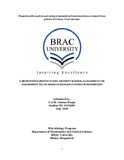Plasmid profile analysis and curing of plasmids in Enterobacteriaceae isolated from patients of Urinary Tract infection

View/
Date
2018-07Publisher
BRAC UniveristyAuthor
Haque, S.A.M. SalmanMetadata
Show full item recordAbstract
Urinary tract infection (UTI) is one of the most frequent bacterial infections worldwide. It is caused recurrently by Escherichia coli and also by Klebsiella spp., Enterobacter spp., Shigella spp. etc. Theyshow resistance to various commonly prescribed antibiotics. They harbor plasmids that might be responsible for antibiotic resistance. This study was undertaken to find a link between antibiotic resistance and plasmids of E. coli, Klebsiella spp., Enterobacter spp., Shigellaspp. Curing was done to investigate if those antibiotic resistance plasmids can be eliminated by treating the isolates with different concentrations of ethidium bromide and sodium dodecyl sulfate. A total of 10 identified isolates obtained from UTI patients of a Diagnostic Center in Bangladesh were investigated. By using Kirby-Bauer Disk Diffusion method, antibiotic susceptibility to various antibiotics were tested. The isolates showed resistance to Azithromycin, Amoxicillin, Gentamicin and Ampicillin. MIC and MBC values for the antibiotics Azithromycin and Ampicillin were also determined by using agar dilution method. After antibiotic susceptibility test was done, the plasmids of the isolates were extracted by Kado-Liu method and separated by using Agarose Gel Electrophoresis. Then the isolates were subjected to plasmid curing procedure with different concentrations of Ethidium Bromide (EtBr) and Sodium Dodecyl Sulfate (SDS). After curing treatment the isolate‘s different strains underwent another antibiotic susceptibility testing. In this study ethidium bromide was more successful in terms of plasmid curing. The isolates which showed plasmid losses after the curing procedure, showed changes in resistance patterns. These results reveal that in terms of the studied isolates, Azithromycin and Gentamicin resistance might be carried in harboring plasmids whereas Amoxicillin resistance is not carried in the plasmid. In the plasmid curing procedure the most effective concentration was proved to be 150μg/ml for Ethidium Bromide and 15% for Sodium Dodecyl sulfate.
